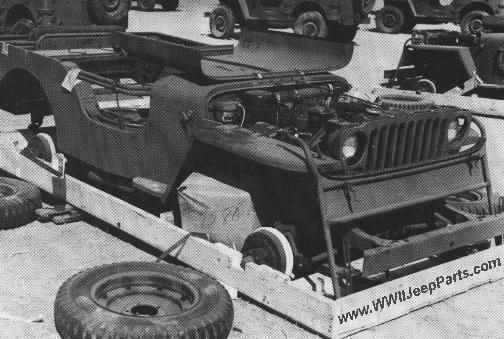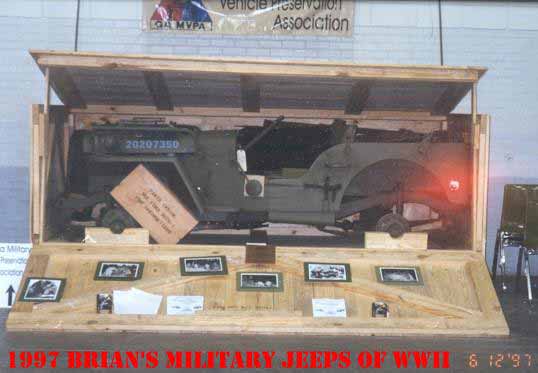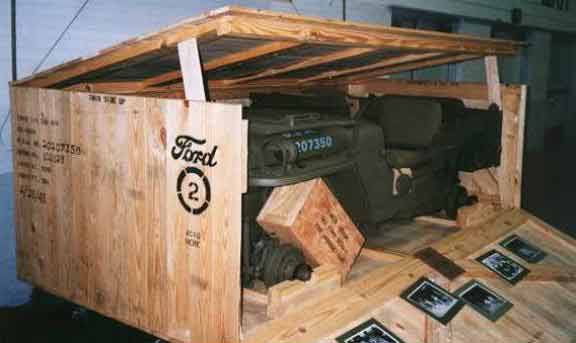* A new urban legend was recently emailed to me. This time it involves
1942 Automobiles rather than jeeps. A lot of wishful thinking goes into
this one too.
I thought you might be interested in something I once read
in an issue of “Collectable Automobile”. I don’t remember which issue,
but one cover story was “The Cars of 1942”. In the article, the writer
mentioned a story that I wish were true: When the government banned the
production of cars in February of that year, they grabbed as many of the
new model as they could for future use, not knowing when car production
would begin again.
A great rumor has it that a lot of those cars still exist today,
crated, and hidden away in a secret and forgotten government warehouse.
They would all be Brand New.
If only!
I’m really sorry I no longer have that issue, but we moved several
times since then, and a lot of stuff was inadvertently thrown away, including
a couple of magazine collections.
One day, I’ll buy a new issue of the magazine and see if this back-issue
is available.
If you know of any crated brand new 1942 cars, please let me know!
Thanks, and have a good day!
Ron
Oh boy! I'll take 20! ;-) If only is right!
** Just received an email from Scott Nelson about 'legend' I haven't
heard of before... Motorcycles in Cans...
Hey, great site! Interested to see the
Jeep in a crate legend - what went around my neighborhood (Northern NJ)
in the mid '60s or so was the word that you could get a "new" WWII era
U.S. Military motorcycle for $50... but it was un-assembled, each part
coated in cosmolene, packed in several 50 gallon drums. Fired our imaginations,
but of course nobody knew how to take the next step, and none of us had
$50 anyway.
We didn't have a real surplus store in the area, but I was
reminded of what used to be a retail staple in many towns - the Army-Navy
store. Don't know why they called them that, exactly - they
had work clothes and shoes, camping stuff, a Boy Scout section.
Thanks, SN
Hey Scott, thanks for emailing. I am glad you liked my website.
Another Enduring Urban
Legend - The empty M-1 Garand clip 'Ping'
Everyone is familiar with "Urban Legends" which
are fantasy stories that have been told and re-told so many times that
some people believe them to be true. One such story has plagued the M1
Garand rifle since at least the time of its adoption in 1936. The "legend"
involves the distinctive "pinging" noise that the empty M1 clip makes when
it is ejected from the rifle. When the M1 was adopted, some of its critics
claimed that this was a serious defect in the rifle because an enemy could
hear the "ping" and would know that the rifle was empty. This "defect"
of the M1 was the cause of many barracks "bull sessions" during World War
II and a number of new recruits were undoubtedly frightened. Even today,
the story is repeated in some books and articles. The "legend" involves
U.S. soldiers who were killed because the enemy was alerted that their
M1 rifle was empty due to the noise of the ejected clip. While there are
multiple variations to the story, they basically involve an American GI
with an empty Garand rifle who was killed when the wily Japanese (or in
some stories, German) heard the sound of the ejected clip, charged cross
the open ground and bayoneted (or shot) the hapless "dogface" while he
fumbled with trying to reload his empty Garand. An interesting twist on
this "legend" involves U.S. soldiers turning the tables on their devious
enemies by dropping empty M1 clips on the ground to simulate the noise
of an ejected clip and then mowing the enemy down when they foolishly revealed
their positions to the Americans with supposedly empty rifles. A variation
of the story stated that members of the U.S. Army First Special Service
Force who were armed with M1941 Johnson Light Machine Guns would fire eight
rounds from their weapons, throw empty M1 clips on the ground and then
use the remaining 12 rounds in their magazines to kill the Germans who
were fooled by this bit of clever deception. Such stories were not limited
to World War II and variants of the "legend" are attributed to the Korean
War when the Red Chinese troops heard the ejected M1 clips hitting the
frozen ground and then killing the Americans with unloaded Garands.
Despite this "legend" being around for over
six decades, there is not one documented instance where an American soldier
was killed because of a noisy ejected M1 clip. Repeat, there is NO official
confirmation of such an incident. If one thinks about it, such a scenario
is actually quite absurd. Anyone who has been in combat will verify that
a battlefield is a noisy and confusing place. To think that an enemy could
hear the sound of an ejected clip several hundred (or even several dozen)
yards away over the din of explosions and the racket of many weapons being
fired is not logical. Even in the case of a close-range firefight, the
scenario does not hold water. Even if an enemy could hear the sound of
an ejected clip, he really couldn't do much in the brief period that it
takes to reload an M1. A GI with a little practice and a lot of incentive
can reload a Garand in just a few seconds. Even Carl Lewis couldn't sprint
very far before he would be faced with an angry American with a fresh eight-round
clip. Also, even if the GI with the empty Garand couldn't reload fast enough,
there would be fellow squad members around with loaded BARs, carbines,
M1919A4 machine guns, Thompson submachine guns and other weapons who would
be only too happy to send the enemy to their fate in the hereafter.
Some British authors who never used the M1
rifle have published this "defect" of the M1 rifle in numerous books and
articles. Even some American writers who should know better have repeated
the same bit of fantasy. While the M1 rifle was not perfect, the fact that
its ejected clip makes a "pinging" noise when it is ejected is not, by
any means, a flaw. If anyone has even a single documented instance of an
American being killed due to this reason, I would be quite interested in
hearing about it. I recall as a kid in the late '50s and early 60's reading
"war stories" in the men's magazines of the day while waiting for a haircut
at the barber shop. At the time, I had never handled (let alone fired)
a M1 rifle and such tales seemed reasonable. However, to anyone with a
knowledge of military small arms and combat situations, it should be readily
apparent that such stories clearly fall into the "Urban Legend" category.
Hopefully, someday, this piece of fantasy will die a natural death. In
the meantime, if you hear a variation of the story being repeated, politely
ask what documentation they have to support it. You will likely hear that
they "read it somewhere" or their brother-in-law's next door neighbor knew
somebody in WWII who was killed because of a noisy M1 clip. That ain't
documentation!

 It
is true that complete factory fresh, running vehicles were crated up and
shipped as SUP's, which is short for 'Single Unit Pack', or a pair
of jeeps crated together as TUP's, which is short for 'Twin Unit
Packs'. The photograph shown here is of a restored WWII Jeep that
has been SUP crated. You should also see this
It
is true that complete factory fresh, running vehicles were crated up and
shipped as SUP's, which is short for 'Single Unit Pack', or a pair
of jeeps crated together as TUP's, which is short for 'Twin Unit
Packs'. The photograph shown here is of a restored WWII Jeep that
has been SUP crated. You should also see this  The
next occurrence of the jeeps in crates story was popular in the 1960's
and 1970's before the US Postal Inspectors cracked down on pyramid type
schemes. That story next...
The
next occurrence of the jeeps in crates story was popular in the 1960's
and 1970's before the US Postal Inspectors cracked down on pyramid type
schemes. That story next...